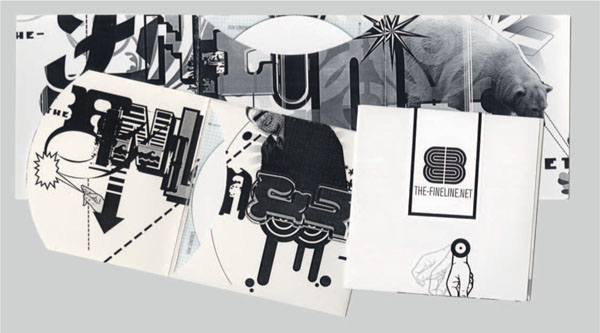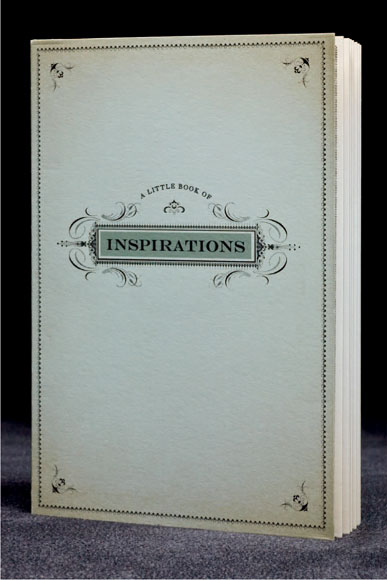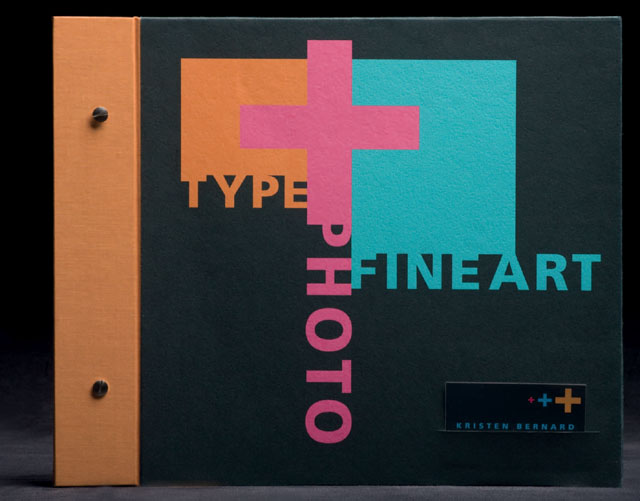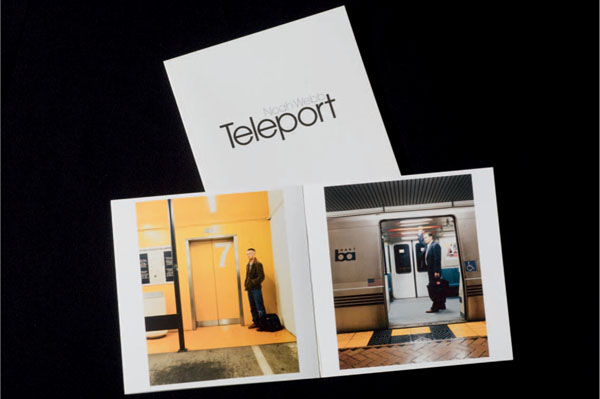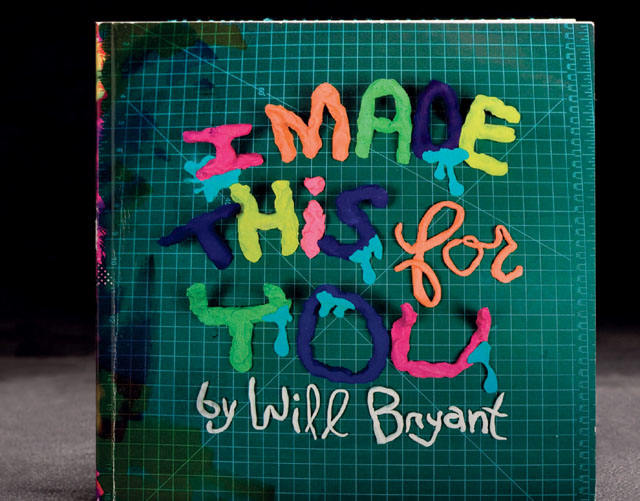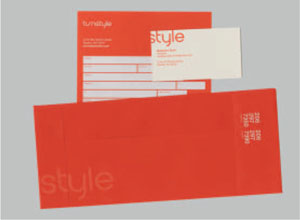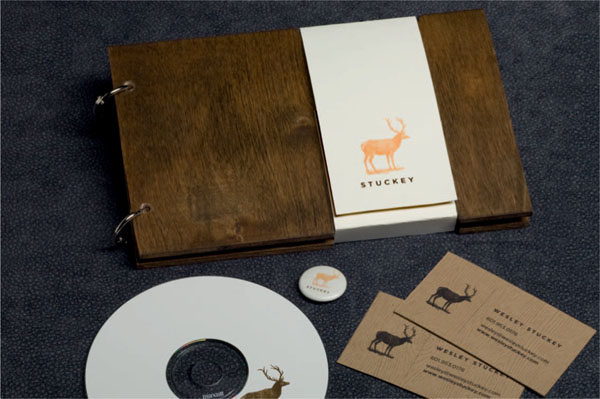STEP TWO
BRANDING
INTRODUCTION
The primary function of your portfolio is to present a collection of your best work in order to communicate your experiences and capabilities, in hopes of securing a position or client. While this purpose cannot be forgotten, your portfolio can also be taken much further. It can become a quintessential marketing piece in and of itself. In doing so, it has the potential to make a more impactful and memorable impression on its intended audience. Your ability to develop ideas and market yourself is not only relevant to working in the creative industries, but it can provide a much-needed advantage in such a competitive field. This is especially important for students and recent grads who have not yet had as many opportunities to distinguish themselves in their careers.
In this chapter, the process of defining and developing a brand will be outlined as related to the development of your portfolio. This chapter will address the following issues:
How do you move from an assortment of work to a clear and concise brand statement?
How do you utilize a process of self-discovery to create a brand statement that can be used as a touchstone in the creation of your entire portfolio package?
First, consider where you are in this process. If you:
- Already have a clear concept or idea for the direction of your portfolio: Use this chapter to reflect and evaluate this idea as it represents and positions you within your field. Developing a brand statement can't hurt—the clearer you are about how to position yourself within the industry, the better you'll be able to do just that. Keep in mind (especially for those of you who do not have a design background) that you can develop a brand statement without developing a corresponding brand identity.
- Already have a brand and corresponding brand identity: Use this chapter to reevaluate it. It may be time to analyze your current brand's strengths and weaknesses, refreshing or changing it if need be.
- Don't know what to say and/or how to say it: Use this chapter to begin a process of self-discovery, defining and shaping your brand position. The work in your portfolio may not be enough to take you where you want to go. While it's difficult to define something, let alone oneself, in the long run it will help you to have a statement that you can use as a touching point in the development of your portfolio design.
A brand is an attitude. It is a symbolic statement comprised of descriptive qualities that aim to express the heart and soul of an individual, company, or product. These qualities are typically defined by a set of brand attributes —a list of descriptive words and phrases that have the power to describe style, tone, and personality; establish connections and associations; and shape emotional reactions. Brands attempt to project certain expectations and promises in the hopes of establishing an emotional and intellectual connection with their target audience. Truly successful brands are able to deliver on those promises through the value that the individual or company provides. Such brands express and establish a specific attitude that is identifiable throughout their particular market.
BRAND
Think about the clothes you wear, the music you like, and the products you buy. Among all of these things you have choices you make based on certain attitudes and qualities that appeal to you. In some ways, these things even go so far as to define aspects of who you are and the broader culture that you belong to. The most successful brands often become timeless icons of culture—think VW, Coca-Cola, MTV and Apple.
A strong brand should:
- Differentiate: Stand out from your competition.
- Be authentic: Communicate a message that is relevant and meaningful to your intended target audience.
- Be memorable: Consistently communicate a clear and concise message.
A brand is the sum of the good, the bad, the ugly, and the off-strategy. If is defined by your best product as well as your worst product. It is defined by award-winning advertising as well as by the god-awful ads that have somehow slipped through the cracks, got approved, and, not surprisingly, sank into oblivion. … Brands are sponges for content, for images, for fleeting feelings. They become psychological concepts held in the minds of the public, where they may stay forever. As such you can't entirely control a brand. At best; you only guide and influence it. 2
—Scott Bedbury, Author, A Brand New World
This means that everything you use to represent yourself will in some way define you—the work in your portfolio, the design and craft of your portfolio, how you conduct yourself on an interview, your resume, your website, and even how you compose an email.
Research and Analysis
- Find out about your target audience: What are they looking for?
- Find out about your competition: Who are you up against?
- Analyze your current brand's strength and weaknesses (if you already have one).
Check out our website or see Appendix A for a list of industry sources.
YOU NOW HAVE TO DECIDE WHAT ‘IMAGE’ YOU WANT FOR YOUR BRAND.
Image means personality.3
DAVID OGILVY
Author, Ogilvy on Advertising
A good place to start thinking about your own brand statement is by reflecting about the work you've done, the person you are, and the creative professional you want to be. In order to do this, there are some key questions that you should ask yourself. Write down the answers that you come up. Trust yourself and listen to your intuition throughout this process. You should also think about getting the opinions of others whom you trust. Ask faculty, clients, fellow designers, photographers, artists, etc., how they would characterize the work you do and the creative person they perceive you to be. Ultimately, you want to focus in on descriptive key words—adjectives and adverbs that can begin to define your brand statement.
Reflect on Your Work
Ask yourself some key questions:
- What kind of work do you like to do?
- What kind of work do you do best?
- Was there a particular project that you really enjoyed working on?
- How would you define your talents and skill set?
- How would you describe the styles, forms, and concepts with which you prefer to work?
- How would others describe your talents and the work you do? (If you don't know, ask.)
- What does your body of work say about you?
- Is there something missing from your body of work that you think you need?
Reflect on Yourself and Interests
Ask yourself some key questions:
- How would you describe yourself as a creative professional?
- How would you describe yourself in general – your personality, work ethic, beliefs, etc.?
- How would others describe you? (If you don't know, ask.)
- Are these qualities communicated through any of the pieces you've worked on?
- What do you have to offer a company or client?
- What types of experiences engage you?
- What do you find most interesting about the world around you?
- What do you find most interesting about photography, art, and/or design?
- Whose work influences, attracts, and inspires you? Why?
Reflect on Your Future
Ask yourself some key questions:
- What kind of work do you want to do?
- What kind of creative do you want to be?
- Are you doing the kinds of things now that you want to be doing in the future?
- If not, how can you position yourself to get to where you want to be?
- What kind of company or client do you want to work for?
- What kind of company would fit your lifestyle? Are there compromises you are willing or not willing to make (travel, moving to a different location, long hours, etc.)?
- Where do you see yourself in one, two, or five years?
- Is there someone in the field who you admire? Would want to emulate? Why? How did they get to where they are?
This is your opportunity to invent yourself for the first time, or reinvent yourself all over again. Think about where you'd like to be two years from now. How about five or ten years? People change jobs and even careers often throughout their lifetime. Now is the time to think about what you want out of your career.
By defining what you show based on what you truly are and what you want to do, you create a self-selection process: you are not for everyone. You are different. Be courageous enough to show that you see in a way no one else does.4
— Doug Menuez, Photographer
INSPIRATION
There are many different places where one can find sources of inspiration. Keep in mind that you can't create in a vacuum. Find what will help get your creative juices flowing.
Looking Outward
Try looking outside of yourself for things that inspire and appeal to you. Go to museums and galleries; browse the shelves at libraries and bookstores; flip through industry magazines and online portfolios. Look at the work that other people have made and ask yourself whether or not you want to create similar work. If so, try to define what you are looking at or experiencing. Try to figure out what characteristics define a particular piece that you are drawn to. What makes it stand out? What makes it meaningful to you? What does it communicate about the artist who made it? Try to be conscious of the various visual things that you are drawn to: patterns, signs, graphics, images, films, typefaces, or anything else to which you feel a connection. You should take some time to explore the things around you.
Genres and Styles
While there are many places from which to draw inspiration, an easy place to start is with a “history of” anthology or “style” book. These types of books explore numerous genres throughout the history of a particular discipline. You'll find artists who have explored any number of concepts, styles, and techniques. You may find that you are drawn to the postmodern, deconstructed typographic styles of Ray Gun and Fuse in the 1990s; or the vibrant psychedelic posters of the 1960s; or the sardonic images of a 1930’s photomontage. Perhaps you will connect with the clean, clear “objective” design of the Swiss Typographic style or the expressive illustrations of Push Pin Studios. Perhaps you will be drawn to American modernism and the abstract, symbolic graphics of Paul Rand, Lester Beall, and Saul Bass. Maybe still, a painting will inspire you, or a landscape, photograph, texture, or pattern.
Photographers should look to both photo history as well as contemporary approaches found in commercial photographic production. Perhaps your work is more in keeping with the late 20th-century study of typologies coming out of German photography or you like the freewheeling framing of Winogrand. Look to fashion photography, which has always repurposed historical forms such as: reportage, early color, alternative process, Polaroid, snapshot aesthetics, and plastic or alternative cameras.
Explore a variety of mediums and forms in your search for inspiration. If a particular genre or artist inspires you, try to determine what it is about their work that you find so appealing. Think about how this is or is not reflected in your own work and the type of work you want to do. Does a particular design style match up with how you define yourself and your work? Will referencing it help communicate your unique qualities as a creative individual?
Process
Keep a sketchbook of inspiration as you search and explore. This process may take some time. If the end result is to be meaningful, it is important that you define a brand that is reflective of your own unique vision, talents, abilities, and personality. In the end, you should feel confident about your own creative identity.
JUDY REED – SILVER, PROMOTIONAL MATERIALS, Calabasas, CA.
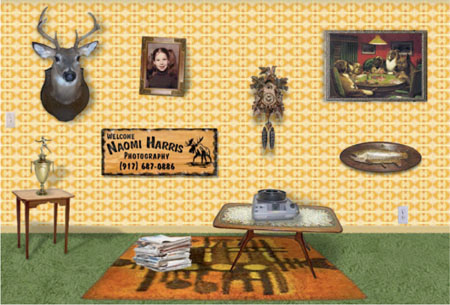
NAOMI HARRIS, PORTFOLIO WEBSITE, New York, NY. Naomi's website plays with the look of 1970’s kitsch.
The girl in the image is my mother-in-law from 1930. The bird was my wonderfully goofy pet ecelectus parrot, Saul. The patterns used here are not of a particular era; even though I do get inspiration from vintage colors, patterns, etc., I try to make the patterns/colors fit the subject. I generally like to work with bright colorful patterns in my pieces as a layering effect, incorporated with painted backgrounds.
—Judy Reed Silver
KENNY KIM, STUDENT PORTFOLIO AND PROMOTIONAL MATERIALS, Kansas City Art Institute.
This piece, influenced by postmodern digital and urban graffi ti trends, combines graffi ti and digital type, comic book symbols, bold shapes, symbols, lines, and eclectic cutout images to communicate a dynamic, raw, and experimental feel. Keeping the design limited to grayscale helps to unify all the elements together into one cohesive piece.
Trends
Consider that certain industries tend to align themselves with certain trends. Think about what is popular in concept and style for the moment. Look to industry leaders, organizations, and publications to find articles and visual examples of what is being called the “latest and greatest.” Consider trends not only from the market you are currently in, but also trends evident in the industry that you want to break into. Ask yourself: What concepts, visual forms, or attitudes are being represented? Then consider if you are already aligned with these or even if want to be.
SOLVITA MARRIOTT, STUDENT PORTFOLIO, Tyler School of Art.
Solvita's portfolio concept emphasizes her creative process and the things that inspire her. Her book design makes reference to a Victorian-style book aesthetic, making associations to the value and respect afforded such of book of that era. Indeed, the craftsmanship of this book is exquisite. A subtle faux foxing technique further affords the piece a more antique look.
While working on ideas for my portfolio book I was looking for a common thread that would bring together my different projects. I noticed that many of my solutions were rooted in history, inspired by a certain art movement, or referenced an image I had seen somewhere while researching for my projects. I decided to make this the theme for my portfolio book. I selected and compared my projects (that had the most obvious inspiration) to the historical reference or original image that influenced the end product. I wanted the viewer to feel the special connection to the history and tradition that inspired my designs.
— SOLVITA MARRIOTT
Q & A: Interview with Kristen Bernard, Graphic Design Student, Endicott College
Kristen Bernard expects to graduate in May 2010 with a B.F.A. in visual communications (concentration in graphic design), and a minor in communications. Kristen has interned at EBSCO Publishing in Ipswich, MA, and freelances as an associate designer for the firm Visual Communications in Lowell, MA. She is an active member of Endicott College's AIGA student chapter. Check out Kristen's website at http://www.kristenbernard.com/
Were you a student when you created this piece? Was it created in response to a course assignment?
At Endicott, we are all expected to complete a portfolio class, where we create a book, website, and other materials. In one assignment, we were directed to “brand” our design style. This was challenging because we had to develop a concept that reflected our individualism, style, and taste for design. To arrive at my concept, I listed some words I thought described who I was and how I designed. I came up with words such as “clean, organized, structured, bold, and balanced.” With these words in mind, I began thinking of the “+” sign with its balance and structure to inspire my book.
How did you arrive at the idea or concept behind your piece? What do you think it communicates about you?
With my cover design, I wanted to demonstrate that I could be counted on for solid graphic design skills—focusing on type, layout, and color. I wanted to communicate a formal, clean, and structured look. For this reason, I choose to reference the Swiss International Typographic style for my inspiration.
What was the most challenging part about creating this piece?
The most challenging piece to this assignment was trying to target who I am as a designer. With limited professional experience, I relied on examining my personality to come up with my “brand.” However, as my personality grows and evolves, I would expect my design to grow and evolve as well.
Who have you sent it out to? How did you send it? What did you follow up with (call, email, etc.)?
As of now, I have not distributed the book to anybody, but have used the resume and an invoice design regularly since December 2008. Resumes were usually printed on a thicker paper stock or emailed as a PDF, and I plan to follow up with both email and phone call.
Do you have any advice for a student currently work on his or her portfolio and/or other promotional materials?
Any advice I could pass on: Collect any design materials you admire, are inspired from, or are generally attracted to, and tape them into a sketchbook. Subscribe to creative publications and become a member on design-based websites. In addition, you may really love an idea you are working on, but be prepared to throw it away and start from scratch if you find yourself going nowhere. Don't force anything.
KRISTEN BERNARD, STUDENT PORTFOLIO, Endicott College.
BRAND ATTRIBUTE
How to Identify Key Brand Attributes
However you come to determine your brand qualities, you will want to narrow down your list and focus on about three to five descriptive words. Choose qualities that best represent your unique capabilities and attitudes. Think about how you would envision translating these qualities into a more tangible “look and feel.” Try to choose brand qualities that will lend themselves to creating a more focused, positive, and memorable impression that distinguishes you.
Words like witty, vintage, bold, intense, organized, daring, confident, imaginative, reflective, quirky, experimental, retro, edgy, outgoing, enthusiastic, focused, classic, raw, poetic, creative, playful, and wacky, are some choices you could use to describe your style.

RACHEL KARACA, STUDENT PORTFOLIO, University of Kansas.
A light-hearted and fun concept, this piece plays with the idea of identity. The design expresses Rachel's personality not only through the concept itself, but also through the copy and visuals used to support it. This unique concept and form is sure to stand out and be memorable. Indeed, it got her a job at Hallmark cards.
This little resume book is what I mailed to Hallmark Cards to get the position I currently (as of May 2008) hold as an associate art director for Shoebox, the humor division. I had to do something unexpected because they get over a thousand resumes a year. And the size was a result of wanting the piece to feel intimate and personal.
— Rachel Karaca
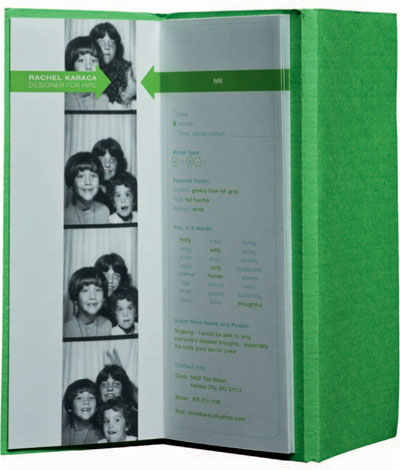
Brand Statements
A brand statement (sometimes known as a brand position) is a single statement that communicates quickly and succinctly the core values of an individual or company as they relate to its strategic positioning within a particular industry.
Personal brand statement: A single sentence that strategically promotes who you are, what you stand for, and what you're best at. It is a difficult process to develop such a statement as it challenges you to focus on your strongest positive attributes and then have the confidence to state them clearly and concisely. Be forward-thinking—take a stand, focus your message, and set yourself apart. A targeted message is guaranteed to make you more visible and memorable.
Don't worry about including all your talents and skills in this statement. You shouldn't include everything you can think of—this will only water down your message. Besides, there is a baseline level of skills and experience that should be true of most people in your industry. Such expectations should be demonstrated through the actual work in your portfolio. Your brand and subsequent portfolio design should, however, go above and beyond a generic description and focus on what makes you special. It's better to be targeted and have something more unique to say than to be too generalized and like everyone else.
Your brand statement will be used as a guide, a touchstone, in the expression of your portfolio concept and design. A personal brand statement can also provide the basis for the development of a visual identity if you decide to create one.
Sample statement:
I am a [state professional title (photographer, graphic designer, illustrator, etc.)] with strong (amazing, leading, etc.) skills in [list core skills] who is [list brand attributes (qualities)].
Exercise: Brand Book
Need help? Think about your brand like you're telling a story about it – one that captures the essence of who you are as a creative professional. In advertising, most brands have a “brand book” that tells their story. Check out Appendix A or our website for resources.
A brand book is the story and personification of a brand—it's ethos. It answers the questions: What does a brand sound like? Feel like? Look like? What's its purpose? It's mission? How is it different from its competitors? What's its unique personality and characteristics? How does it think and perceive the world? How does the world perceive it? Through visual elements and copy a brand book tells its story—written in the first-person narrative form as if the brand (or company it is representing) is speaking.
— Christine Pillsbury, Creative Director, Beam Interactive and Relationship Marketing
NOAH WEBB, PROMOTIONAL BOOK, CA.
Noah Webb's promotional book is characteristic of clean, modern design. The typeface used is ITC Avant Garde, which was designed by the masterful Herb Lubalin as a logotype for a magazine collaboration. Its geometric precision references the postmodern art deco of the 1960s.
Q&A: Interview with Will Bryant, Recent B.F.A. Graduate, Mississippi State University, Mississippi State, MS
Will Bryant makes stuff as a freelance creative at the shared studio space Public School in Austin, TX. Will is primarily an illustrator and artist, but also enjoys identity and print design. He graduated from Mississippi State University in 2008 with a B.F.A. in graphic design. Check out his website at www.will-bryant.com/.
Were you a student when you created this piece? Was it created in response to a course assignment?
Yes, my final semester of undergrad (December 2008) at Mississippi State University. As an existing senior graphic design student at MSU we are required to create a self-promo. Typically, these are difficult and expensive to reproduce.
How did you arrive at the idea or concept for your piece? What do you think it communicates about you?
I wanted to create something I could easily reproduce in order to distribute to more people. My inspiration came from Frank Chimero's “The Small Print” book. He was very helpful (always is)!
I think it definitely showcases my personality and infatuation with hand lettering, bright colors, and light-hearted content.
Did you target a particular area of the market or industry with this approach?
Yes and no. It definitely showcases my illustration work more than design, so I'm planning on self-publishing another book to showcase that aspect of my skills.
What was the most challenging part about creating this piece?
The hardest part was definitely laying it all out. I didn't take the time to really edit myself or construct a systematic way of ordering the book, which I will definitely do in the future.
Who have you sent it out to? How did you send it? What did you follow up with (call, email, etc.)?
I've sent my portfolio to WK12, Decoder Ring, John of Advice to Sink in Slowly, Chris of Gorilla vs. Bear, and Domy Books. I just mailed it in a standard envelope and included a print among other brightly colored collateral (buttons and moo cards).
I've definitely followed up with email for the most part. I've visited the fine folks at Decoder Ring, and I would say meeting in person is the best.
What was the response?
Generally it has been very pleasant. Most people are genuinely impressed and it has sparked an interest to use Lulu for their own projects. On the other hand, I haven't landed a full-time job from this book. It is getting recognition and selling well … so high five!
Do you have any advice for a student currently work on his or her portfolio and/or other promotional materials?
Definitely try to showcase both your work and your personality.
Depending on what you're wanting to do in a creative field, that resume of yours can be secondary to the creation of your portfolio. Having it as a separate piece that just slips in something has been really nice. I've been able to show my book and then just leave behind a resume.
WILL BRYANT, STUDENT PORTFOLIO, Mississippi State University.
BRAND IDENTITY
Design must seduce, shape, and perhaps more importantly, evoke an emotional response.
— April Greiman, Influential Designer
While brands speak to the mind and heart, the brand identity is tangible and appeals to the senses. Identity supports, expresses, communicates, synthesizes and visualizes the brand. 5
— Alina Wheeler, Author, Designing Brand Identity
Once you have created a brand statement, you can begin to think about the visual and verbal properties that will best communicate your message. For some of you, that may develop into a brand identity.
A brand identity consists of both visual and verbal properties that work together to create a tangible representation of the qualities outlined by the brand. The best brand identities are memorable, authentic, and differentiate themselves from their competition. They assert the brand attitude with confidence and enthusiasm.
Note: A Brand Identity isn't for Everyone
The following discusses the traditional components of a brand identity. Depending on your specific discipline and relevant goals, some of these aspects may not be applicable to your needs. You don't, for example, need to create a company name or logotype in order to create a successful identity for yourself and your portfolio. In fact, many of you may decide not to create a formal, visible brand identity at all. However, with that said, it is still a good idea for you to have an understanding of how and why a brand identity is used and relevant to the development of your portfolio. At the very least you should consider a visual aesthetic that will work best to represent you—strategize and develop at least some visual and verbal properties that can remain consistent and be used effectively to communicate across multiple forms and mediums.
Even if the brand identity is not published or visible, to have one, to work to create one, is vital for making a coherent book. It is the guiding light that shapes the “flavor” of what one chooses to include in any portfolio.
— Valan Evers, Photographer and Faculty, The Art Institute of Fort Lauderdale
Verbal Components
The most prominent verbal components of a brand identity typically include name and tagline. However, all copy written for advertising concepts and marketing purposes contributes to a brand identity. Such copy communicates a specific tone of voice and attitude relevant to the brand. Keep in mind that a message is only ever as good as its delivery. While you probably don't need a company name or tagline (your own name will suffice) you should think about differentiating yourself with some engaging copy—perhaps simply as the title of your book.
The following examples (taken from portfolio and promotional pieces in this book) demonstrate effective copy; that is, the title is an integral part of the portfolio's brand and concept and works well to differentiate the book.
- Body of Work by Jessica Hische
- Blood Makes the Grass Grow by Anthony Georgis
- I Made This by Will Bryant
- A Little Book of Inspirations by Solvita Marriot
Visual Components
Key visual brand components typically include a logotype, specific color palette, particular stylization of imagery/iconography, and typographic selections. As creative individuals we are in the business of concerning ourselves with working to translate ideas and abstract qualities into tangible and cohesive visual messages. Such is the process of developing a visual identity from a brand statement. In the art and design world this is often referred to as the “look and feel.” Visual properties as defined by color, image, symbol, material, typeface, and even composition are given significant consideration to make sure that the “look” accurately works to communicate the desired “feel” of the message. For example: The look of a fractured composition could feel edgy; the look of diagonally composed type could feel dynamic; and the look of a large red bull's eye could feel confident and bold.
For a visual identity to be successful it must do three things.
1. It must be distinct enough to stand out from the crowd—it must get you noticed. A successful visual identity should be unique enough to grab someone's attention and also hold his or her interest.
2. It must be meaningful. A visual identity should communicate something that is real. Like an overall brand identity, it projects an expectation that in order to be successful must be realized by the person or thing to which it is referring. In other words, the work in your portfolio should back up the attitudes and qualities expressed through your visual identity.
3. It must be memorable. To do this, the visual identity needs to be applied consistently to all aspects of the comprehensive portfolio. If someone were to view your portfolio book, website, or even business card for just a minute, it should make a solid enough impression that the “look and feel” could be described hours later. For example, that portfolio was “bold, dynamic, and witty—a perfect fit for our company!”
Additional Components
Audio and motion can be a powerful part of a brand identity and can help establish mood and tone. Such aspects should be especially thought about when you approach your online portfolio.
Style Guide
A brand identity is typically defined in a document called a style guide. This document is used as a reference for all aspects of a brand's marketing materials. A style guide is often very specific about how visual and verbal components of the brand should be used. It can include directions regarding logo and image placement, color palette, size and proportions, image stylization, grid systems, materials, typographic systems, and even types of media to be used. All of these aspects are meant to work together to establish a distinct and consistent brand style. This same strategy can be applied, more or less, to the creation of your comprehensive portfolio. In the next chapter you will explore applying your brand identity to your portfolio book's front and back cover design.
TURN STYLE STUDIO, Seattle, WA.
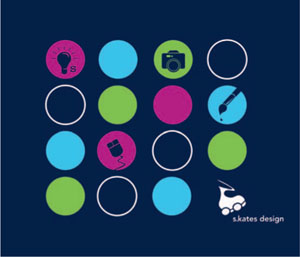
STEPHANIE KATES, Endicott College.
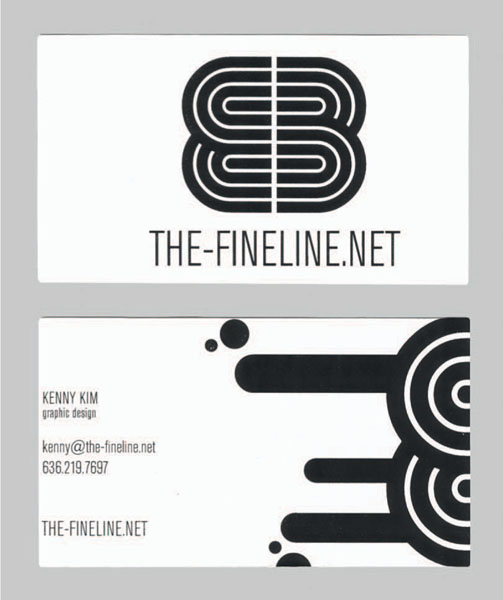
KENNY KIM, New York, NY.
Kenny Kim's logo and business card design style blends distinctly Asian and graffiti aesthetics.
WESLEY STUCKEY, STUDENT PORTFOLIO AND PROMOTIONAL MATERIALS, Mississippi State University.
Inspired by his love of nature and printmaking, Wesley's portfolio package has a rustic, hands-on, and natural appeal. At the same time, his attention to detail and craftsmanship is quite evident.
Q&A: Interview with Christine Pillsbury, Creative Director, BEAM Interactive & Relationship Marketing
Christine Pillsbury is a creative director at BEAM Interactive & Relationship Marketing in Boston. She has held previous positions at Mullen, U.S. Interactive, and Ogilvy and Mather in New York. She is the recipient of numerous industry awards, including the London International Advertising award, One Show Interactive award, and HATCH award. Ms. Pillsbury has an M.F.A. in dynamic media from Massachusetts College of Art.
How important do you feel an online and/or print portfolio is in securing a creative position in the interactive design industry?
Essential—don't bother without it. Seriously.
As a creative director, what do you look for in an online portfolio? What contributes to an overall portfolio design that stands out and grabs your attention?
First and foremost, the work. But a half-thought-out “container” can definitely take away from good work, while a great portfolio concept can really differentiate you.
How important do you think a brand or overall visual identity is in the success of a portfolio design?
Brand is so much more important than branding. I'm not looking for your cool logo, but I am trying to find out who you are, what you can do, what's interesting about you, what makes you different, and where you are going.
In general, how many pieces of work do you think a student should include in his or her portfolio?
It depends … 12 is a good number. I definitely think quality over quantity. People aren't going to sift through project after project looking for “it.” The best portfolios are full of individual projects that demonstrate multiple skills and talents at the same time.
Do you have any advice for someone (especially a student) who is working on his or her portfolio and/or other promotional materials?
The people reviewing your work probably don't have a lot of time to spare; first impressions are literally make it or break it in this industry.
Brand is so much more important than branding.
I'M NOT LOOKING FOR YOUR COOL LOGO, but I am trying to find out who you are, what you can do, what's interesting about you, what makes you different, and where you are going.
CHRISTINE PILLSBURY
Creative Director, BEAM Interactive & Relationship Marketing, Boston, MA
Q&A: Interview with Jeremie Dunning, Senior Web Designer, Burton Creative Services
Jeremie Dunning is a senior web designer with Burton Creative Services in Burlington, VT. Jeremie's background includes print, web, and film. He has worked for several ad agencies and as a film editor in Los Angeles, and owned his own creative shop for both print and web. Jeremie holds a B.A. in communications with a minor in marketing from SUNY Fredonia in New York.
How important do you feel an online and/or print portfolio is in securing a creative position in your industry?
It's a requirement even to be considered for the position. After that, it's really all about the interview.
I think both print and web portfolios are important. Both mediums can communicate who you are beyond just the work itself. The packaging and presentation of a portfolio can really say a lot about you.
On the web side at Burton, the online piece is obviously really important. I'm looking to see that a portfolio maintains the full integrity of a project, not just a JPEG of the project or a screen capture. I want to see interactivity and functionality—proof that you can make your vision successful online.
It's also great to have a book that you can carry with you (and not need a computer to view your work). A print portfolio has the potential to really stand out. This probably isn't something that's mass-produced, so the craftsmanship is really important. You should send your book to companies that you want to engage with. There may be only five of these books in the world, so there's something special about that.
What do you look for in a portfolio? What contributes to an overall portfolio design or construction that stands out and grabs your attention?
I really look at the portfolio's presentation—even more so than the work. I think it's important to see your personality come through so I can get a sense of who you are and what your potential is. I'm trying to figure out if you're a good fit for the company. From an art director's perspective it's important to know how your relationship to the company and to the team will be defined.
How important do you think a brand or overall visual identity is in the success of a portfolio design?
Top of the list—in essence you are selling yourself as a person, as a creative, and a talent. You are not selling the work you have previously done—you are not a salesman.
In general, how many pieces of work do you think a student should include in his or her portfolio?
It's all relative and depends on how you draw me in. If you show me your process I will probably look at more pieces. If you tell me a story with your work and engage me I will look at your portfolio in a more thorough way. It's about telling your story. I'm more interested in your process—the way you think and what you're passionate about. For that reason I'm less interested in the final result.
Professional works in a portfolio are usually art directed by someone else. So personal projects are of more interest to me—they show me where you can and want to go. It's really important for everyone's portfolio to include personal work—it shows me that you are passionate about what you do and that's key. I want to see sketches, brainstorming ideas—in multiple directions. Without this, I tend to trash the portfolio.
Do you have any advice for a student currently working on his or her portfolio and/or other promotional materials?
If you've seen it before, don't do it again. Odds are someone else will have seen it before too.


